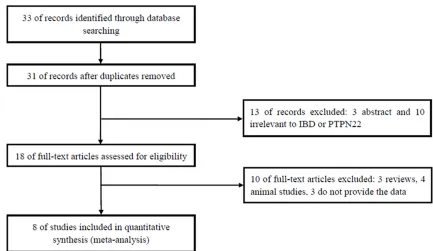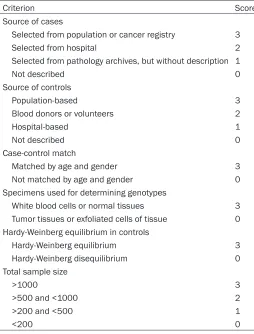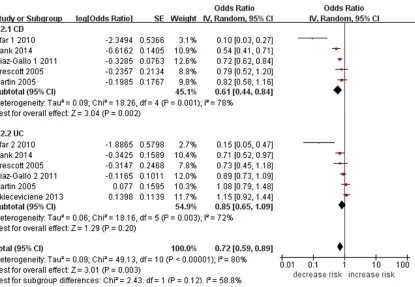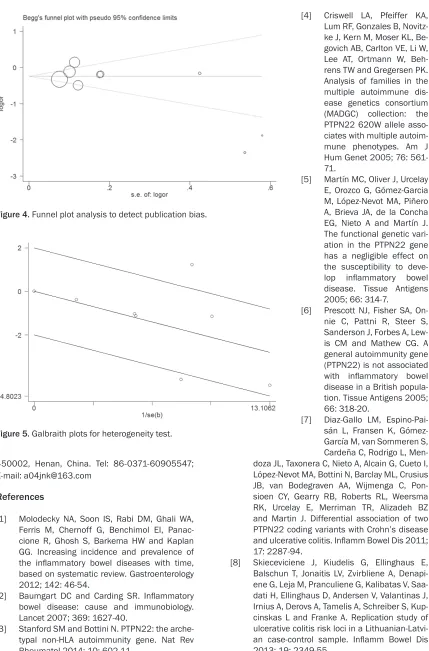Review Article
Protein tyrosine phosphatase nonreceptor
type 22 (PTPN22) gene R620W polymorphism
is associated with inflammatory bowel disease risk
Xiangchen Li
1, Mingliao Niu
2, Huiju Yang
3, Fengrui Zhou
4, Zuowu Xi
21General Surgery Ward 3 of Xinxiang Central Hospital, Xinxiang, Henan, China; 2Anorectal Section of Henan
Prov-ince Hospital of Traditional Chinese Medicine, Zhengzhou 450002, Henan, China; 3Anorectal Section of The Third
Hospital Affiliated to Henan University of Traditional Chinese Medicine, Zhengzhou, Henan, China; 4Department of
Liver Disease, The Sixth People’s Hospital of Zhengzhou, Zhengzhou, Henan, China
Received August 25, 2016; Accepted May 18, 2017; Epub July 15, 2017; Published July 30, 2017
Abstract: Previous studies reported that Protein tyrosine phosphatase nonreceptor type 22 (PTPN22) R620W
poly-morphism may be associated with inflammatory bowel diseases (IBD) risk. However, the data are inconsistent. The aim of our study was to determine the association between PTPN22 R620W polymorphism and IBD in a
meta-analysis. Online electronic databases were searched. The strength of the association between PTPN22 R620W
polymorphism and IBD was measured by odds ratio (OR) and 95% confidence interval (CI). A total of ten studies with 16151 cases and 22360 controls were included in this meta-analysis. PTPN22 R620W polymorphism was signifi
-cantly associated with the risk of IBD (OR=0.71; 95% CI, 0.56-0.90; I2=81%). In the subgroup analysis, a significantly
decreased CD risk were observed (OR=0.61; 95% CI, 0.44-0.84; I2=78%). However, PTPN22 R620W polymorphism
was not associated with the risk of UC (OR=0.85; 95% CI, 0.65-1.09; I2=72%). This meta-analysis suggested that
PTPN22 R620W polymorphism was significantly associated with the risk of CD in Caucasians.
Keywords: Inflammatory bowel diseases, PTPN22, meta-analysis
Introduction
The inflammatory bowel diseases (IBD), Crohn’s
disease (CD) and ulcerative colitis (UC), which
is a chronic relapsing and remitting inflamma
-tory condition of the gastrointestinal tract,
affect a large number of Europeans [1].
Des-pite the introduction of new treatments, many
of these therapies have significant undesirable
side effects [2].
Protein tyrosine phosphatase nonreceptor ty-
pe 22 (PTPN22) located on chromosome 1p-
13, encodes a lymphoid-specific phosphatase
(Lyp). A non-synonymous SNP, R620W (also
referred to as C1858T or rs2476601), located
in the PTPN22 has been repeatedly associ-
ated with a wide range of autoimmune
diseas-es [3]. Previous studidiseas-es reported that PTPN22
R620W polymorphism may be associated with
IBD risk. However, the data are inconsistent
[4-11]. The aim of our study was to determine
the association between PTPN22 R620W po-
lymorphism and IBD in a meta-analysis.
Materials and methods
Publication search
Online electronic databases (PubMed,
EMB-ASE, and Wanfang database) were searched
using the search terms: (“Protein tyrosine pho-
sphatase nonreceptor type 22” or PTPN22)
and (polymorphism or variant orvariation) and
(“inflammatory bowel diseases” or “IBD”). The
reference lists of related articles were also
manually examined. There was no language
and time restriction.
Study selection
Figure 1. Flow of study identification, inclusion, and exclusion.
IBD; (3) sufficient published data about
sam-ple size, odds ratio (OR), and 95% confidence
interval (CI). Studies were excluded when they
were: (1) duplicate publication; (2)
meta-analy-ses, letters, reviews, or editorial articles.
Quality score assessment
The quality of the studies was independently
assessed by two investigators according to a
set of predetermined criteria which was
extract-ed and modifiextract-ed from previous studies [12].
These scores were based on traditional
epide-miological considerations, as well as cancer
genetic issues. Any disagreement was resolved
by discussion between the two investigators.
Scores ranged from the lowest zero to the
high-est 18. Articles scoring <12 were classified as
“low quality”, and those ≥12 as “high quality”.
Data extraction
Two investigators extracted the data
indepen-dently. Data on first author, year of publication,
race, age, gender, type of IBD, numbers of case
and control, and Hardy-Weinberg equilibrium
(HWE) were extracted.
Statistical analysis
The strength of the association between
PTPN22 R620W polymorphism and IBD risk
was calculated with the ORs and respective
95% CIs. The significance of the pooled OR
was determined by the Z test, and
P
-values of
less than 0.05 were considered significant.
Statistical heterogeneity among studies was
assessed with the I
2statistics. This value
rang-es from 0% (complete consistency) to 100%
(complete inconsistency). IBD is commonly
classified into UC and CD. Thus we did a sub
-group analysis by the type of IBD. The Galbraith
plot was used to find the source of the hetero
-geneity. The random-effects model was cho-
sen to calculate the pooled OR. The presence
of publication bias was assessed by a visual
inspection of a funnel plot. All statistical tests
were used by the Revman 5.1 software (Nordic
Cochrane Center, Copenhagen, Denmark) and
STATA 11.0 software (Stata Corporation, Co-
llege Station, TX).
Results
Eligible studies
meta-Table 1.
Characteristics of included studies
First author Year Ethnicity Age Gender of IBDType Source of controls Case (n) Control (n) Hardy-Weinberg equilibrium Genotying Type Quality scores
Criswell 2005 Caucasian NA Mixed IBD Hospital-based 41 705 Yes PCR-RFLP 8
Martin 2005 Caucasian NA Mixed Both Population-based 1113 812 Yes PCR-RFLP 10
Prescott 2005 Caucasian NA Mixed Both Hospital-based 514 374 Yes PCR-RFLP 11
Sfar 1 2010 Caucasian 36 Mixed CD Hospital-based 105 100 Yes PCR-RFLP 9
Sfar 2 2010 Caucasian 36 Mixed UC Hospital-based 59 100 Yes PCR-RFLP 8
Diaz-Gallo 1 2011 Caucasian NA Mixed CD Population-based 6977 9254 Yes TaqMan SNP Genotyping Assay 16
Diaz-Gallo 2 2011 Caucasian NA Mixed UC Population-based 5695 8766 Yes TaqMan SNP Genotyping Assay 16
Skieceviciene 2013 Caucasian 44.4 Mixed UC Population-based 447 1154 Yes TaqMan SNP Genotyping Assay 14
Chen 2013 Asian 41.3 Mixed UC Hospital-based 165 300 NA PCR-RFLP 14
Bank 2014 Caucasian 43 Mixed Both Population-based 1035 795 Yes PCR 16
[image:3.792.90.714.85.242.2]Table 2.
Scale for quality assessment
Criterion Score
Source of cases
Selected from population or cancer registry 3
Selected from hospital 2
Selected from pathology archives, but without description 1
Not described 0
Source of controls
Population-based 3
Blood donors or volunteers 2
Hospital-based 1
Not described 0
Case-control match
Matched by age and gender 3
Not matched by age and gender 0
Specimens used for determining genotypes
White blood cells or normal tissues 3
Tumor tissues or exfoliated cells of tissue 0 Hardy-Weinberg equilibrium in controls
Hardy-Weinberg equilibrium 3
Hardy-Weinberg disequilibrium 0
Total sample size
>1000 3
>500 and <1000 2
>200 and <500 1
<200 0
analysis. One study included Asians. All of the
rest studies were Caucasians. In addition, all
the studies were in HWE. The characteristics of
the studies are listed in
Table 1
. The Scale for
quality assessment is listed in
Table 2
. Quality
scores for the individual studies ranged from 8
to 16.
Quantitative data synthesis
PTPN22 R620W polymorphism was significant
-ly associated with the risk of IBD (OR=0.71;
95% CI, 0.56-0.90; I
2=81%;
Figure 2
). In the
subgroup analysis, a significantly decreased
CD risk were observed (OR=0.61; 95% CI,
0.44-0.84; I
2=78%;
Figure 2
). However, PTPN22
R620W polymorphism was not associated with
the risk of UC (OR=0.85; 95% CI, 0.65-1.09;
I
2=72%;
Figure 3
). The study by Chen et al. [11]
was not in meta-analysis since the distribution
of PTPN22 R620W frequencies did not differ
between UC patients and the healthy controls.
Funnel plot was performed to assess the
publi-cation bias of literatures. The shape of the
fun-nel plot did not reveal any evidence
of obvious asymmetry (P=0.187;
Figure 4
). The Galbraith plot was
used to find the source of the
he-terogeneity. As shown in
Figure 5
,
four studies were the outliers. After
excluding these studies, the be-
tween-study heterogeneity decrea-
sed (
I
2=0%). In addition, when we
excluded these studies, the result
was not changed (OR=0.79; 95% CI,
0.71-0.88;
I
2=0%).
Discussion
In this meta-analysis, we found that
PTPN22 R620W polymorphism was
significantly associated with the risk
of IBD. In the subgroup analysis, we
also observed that this
polymor-phism was significantly associated
with CD risk, but not UC risk. It was
possible that different genetic
fac-tors may account for this
discrepan-cy. Additionally, the heterogeneity
may also influence the results.
The R620W polymorphism disrupts
the interaction between Lck and
LYP, leading to reduced
phosphory-lation of LYP, which ultimately
con-tributes to gain-of-function inhibition of T-cell
activation [13]. Thus, it is plausible that this
genetic discrepancy in PTPN22 influences a
range of diseases. Lester et al. suggested that
PTPN22 R620W minor allele is a genetic risk
factor for giant cell arteritis [14]. Goulielmos et
al. demonstrates that PTPN22 was associated
with increased risk of juvenile idiopathic arthri
-tis in Greek sample [15]. Salinas-Santander et
al. suggested the possible involvement of the T
allele of the PTPN22 C1858T SNP as a genetic
risk factor for this type of alopecia areata [16].
Xiong et al. shows a significant association
between PTPN22 R620W polymorphism and
myasthenia gravis risk [17].
This study had some advantages. First, this
meta-analysis included 16151 cases and 223-
60 controls. Therefore, the statistical power
was enough. Second, funnel plots did not find
publication bias. Finally, the heterogeneity was
decreased in the Galbraith plot.
suf-Figure 2. Meta-analysis of the association between PTPN22 R620W polymorphism and IBD risk.
Figure 3. Subgroup analysis of the association between PTPN22 R620W polymorphism and IBD risk.
ficient for a comprehensive analysis, particu
-larly for Asians and Africans. Second, lack of
the original data of the reviewed studies limited
our further evaluation of potential interactions,
because the interactions between
gene-to-gene and gene-to-gene-to-environment may modulate
IBD risk.
In conclusion, this meta-analysis suggested
that PTPN22 R620W polymorphism was signifi
-cantly associated with the risk of CD in
Caucasians.
Disclosure of conflict of interest
None.
Address correspondence to: Zuowu Xi, Anorectal Section of Henan Province Hospital of Traditional
[image:5.612.104.519.275.562.2]Figure 4. Funnel plot analysis to detect publication bias.
Figure 5. Galbraith plots for heterogeneity test.
450002, Henan, China. Tel: 86-0371-60905547;
E-mail: a04jnk@163.com
References
[1] Molodecky NA, Soon IS, Rabi DM, Ghali WA, Ferris M, Chernoff G, Benchimol EI, Panac
-cione R, Ghosh S, Barkema HW and Kaplan GG. Increasing incidence and prevalence of the inflammatory bowel diseases with time, based on systematic review. Gastroenterology
2012; 142: 46-54.
[2] Baumgart DC and Carding SR. Inflammatory
bowel disease: cause and immunobiology. Lancet 2007; 369: 1627-40.
[3] Stanford SM and Bottini N. PTPN22: the arche -typal non-HLA autoimmunity gene. Nat Rev Rheumatol 2014; 10: 602-11.
[4] Criswell LA, Pfeiffer KA, Lum RF, Gonzales B, Novitz
-ke J, Kern M, Moser KL, Be
-govich AB, Carlton VE, Li W, Lee AT, Ortmann W, Beh
-rens TW and Gregersen PK.
Analysis of families in the multiple autoimmune dis-ease genetics consortium
(MADGC) collection: the
PTPN22 620W allele asso-ciates with multiple autoim-mune phenotypes. Am J
Hum Genet 2005; 76:
561-71.
[5] Martín MC, Oliver J, Urcelay E, Orozco G, Gómez-Garcia M, López-Nevot MA, Piñero A, Brieva JA, de la Concha EG, Nieto A and Martín J.
The functional genetic vari-ation in the PTPN22 gene has a negligible effect on the susceptibility to deve-
lop inflammatory bowel
disease. Tissue Antigens 2005; 66: 314-7.
[6] Prescott NJ, Fisher SA, On-nie C, Pattni R, Steer S, Sanderson J, Forbes A,
Lew-is CM and Mathew CG. A
general autoimmunity gene (PTPN22) is not associated
with inflammatory bowel disease in a British popula -tion. Tissue Antigens 2005; 66: 318-20.
[7] Diaz-Gallo LM, Espino-Pai-sán L, Fransen K, Gómez-García M, van Sommeren S, Cardeña C, Rodrigo L, Men
-doza JL, Taxonera C, Nieto A, Alcain G, Cueto I, López-Nevot MA, Bottini N, Barclay ML, Crusius JB, van Bodegraven AA, Wijmenga C, Pon-sioen CY, Gearry RB, Roberts RL, Weersma RK, Urcelay E, Merriman TR, Alizadeh BZ and Martin J. Differential association of two PTPN22 coding variants with Crohn’s disease and ulcerative colitis. Inflamm Bowel Dis 2011;
17: 2287-94.
[8] Skieceviciene J, Kiudelis G, Ellinghaus E, Balschun T, Jonaitis LV, Zvirbliene A, Denapi
-ene G, Leja M, Pranculi-ene G, Kalibatas V, Saa
-dati H, Ellinghaus D, Andersen V, Valantinas J, Irnius A, Derovs A, Tamelis A, Schreiber S, Kup
-cinskas L and Franke A. Replication study of ulcerative colitis risk loci in a Lithuanian-Latvi
-an case-control sample. Inflamm Bowel Dis
[9] Bank S, Skytt Andersen P, Burisch J, Pedersen N, Roug S, Galsgaard J, Ydegaard Turino S, Brodersen JB, Rashid S, Kaiser Rasmussen B, Avlund S, Bastholm Olesen T, Jürgen Hoffmann H, Kragh Thomsen M, Ostergaard Thomsen V, Frydenberg M, Andersen Nexø B, Sode J, Vogel U and Andersen V. Polymorphisms in the in
-flammatory pathway genes TLR2, TLR4, TLR9, LY96, NFKBIA, NFKB1, TNFA, TNFRSF1A, IL6R, IL10, IL23R, PTPN22, and PPARG are associ
-ated with susceptibility of inflammatory bowel disease in a Danish cohort. PLoS One 2014; 9:
e98815.
[10] Sfar I, Ben Aleya W, Mouelhi L, Aouadi H, Ben Rhomdhane T, Makhlouf M, Ayed-Jendoubi S, Gargaoui H, Najjar T, Ben Abdallah T, Ayed K and Gorgi Y. Lymphoid tyrosine phosphatase R620W variant and inflammatory bowel dis
-ease in Tunisia. World J Gastroenterol 2010;
16: 479-83.
[11] Chen Z, Zhang H, Xia B, Wang P, Jiang T, Song
M and Wu J. Association of PTPN22 gene (rs2488457) polymorphism with ulcerative cols of PTPN22 mRNA in ulcerative colitis. Int J
Colorectal Dis 2013; 28: 1351-8.
[12] Wang F, Sun G, Zou Y, Fan L, Song B. Lack of
association of miR-146a rs2910164 polymor-phism with gastrointestinal cancers: evidence from 10206 subjects. PLoS One 2012; 7: e39623.
[13] Zhang J, Zahir N, Jiang Q, Miliotis H, Heyraud S,
Meng X, Dong B, Xie G, Qiu F, Hao Z, McCulloch CA, Keystone EC, Peterson AC and Siminovitch KA. The autoimmune disease-associated
PTPN22 variant promotes calpain-mediated Lyp/Pep degradation associated with lympho-cyte and dendritic cell hyperresponsiveness.
Nat Genet 2011; 43: 902-7.
[14] Lester S, Hewitt AW, Ruediger CD, Bradbury L, De Smit E, Wiese MD, Black R, Harrison A, Jones G, Littlejohn GO, Merriman TR, Shen
-stone B, Smith MD, Rischmueller M, Brown MA
and Hill CL. PTPN22 R620W minor allele is a
genetic risk factor for giant cell arteritis. RMD
Open 2016; 2: e000246.
[15] Goulielmos GN, Chiaroni-Clarke RC, Dimopou
-lou DG, Zervou MI, Trachana M, Pratsidou-Gertsi P, Garyfallos A and Ellis JA. Association
of juvenile idiopathic arthritis with PTPN22
rs2476601 is specific to females in a Greek
population. Pediatr Rheumatol Online J 2016; 14: 25.
[16] Salinas-Santander M, Sánchez-Domínguez C, Cantú-Salinas C, Gonzalez-Cárdenas H, Ce-peda-Nieto AC, Cerda-Flores RM, Ortiz-López R
and Ocampo-Candiani J. Association between PTPN22 C1858T polymorphism and alopecia
areata risk. Exp Ther Med 2015; 10: 1953-8.
[17] Xiong X, Xiang M, Cheng X and Huang Y. PTPN22 R620W Polymorphism is associated




